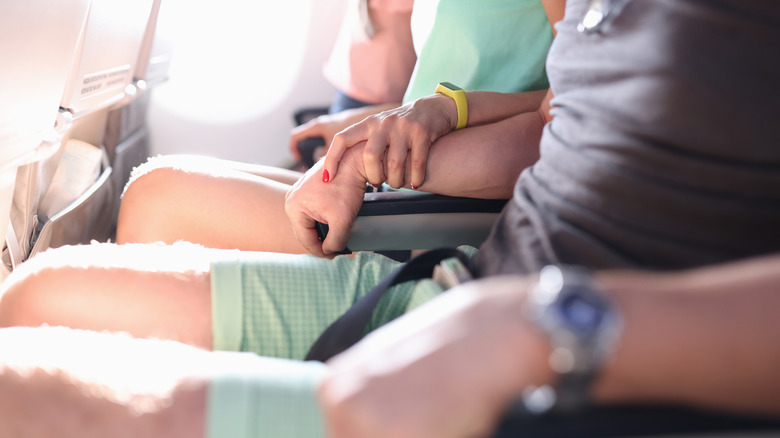You Need To Hear Out This TikToker's Genius Jello Theory If You Have A Fear Of Flying
The idea of soaring in metal through the sky can be scary, even for those who have flown countless times. For people with aerophobia — an intense fear of flying — boarding a flight can trigger panic attacks, heart palpitations, and other symptoms. Some people may avoid air travel altogether due to the phobia. Shakes and bumps caused by turbulence are one reason for feeling anxious on a plane. However, even if it feels like the aircraft is about to fall out of the sky, TikToker Anna Paul shared a helpful metaphor to remind us all that turbulence isn't as dangerous as it feels.
In a video, the content creator holds a cup of jello, explaining that, according to her theory, the jello represents the air in the atmosphere. She then takes a balled-up napkin, representing a plane, and sticks it in the jello, where it sits without sinking. "And that is you flying through the sky: There's pressure from the bottom, pressure from the top, from the sides, pressure coming from everywhere," Paul explains.
The TikToker then taps on the jello to simulate turbulence, which jolts the ball inside. "You feel the plane shaking, but [it's] not just gonna fall down, you know, it's stuck in there 'cause there's pressure coming from the bottom and the sides." She adds that there's never been a plane crash from turbulence alone, which puts some of our worst fears about flying to rest.
What exactly is turbulence anyway?
While Anna Paul's jello theory can make flying a little less scary, we all know that we're not really flying through a cup of jello when traveling through the sky. So what exactly is turbulence, and what causes it? Put simply, turbulence is a disruption in regular air movement. While air generally flows in smooth and predictable ways, it sometimes becomes choppy, creating turbulence in the planes passing through.
This irregular movement has several potential causes. First, turbulence can be triggered by the terrain of the ground below. For example, if you're flying low over a mountain range, you might experience bumpiness due to the wind blowing over those ridges and peaks. Turbulence can also be caused by differences in air temperature when warm air rises and pushes cooler air further down. Similarly, two air masses with different temperatures can also cause friction in the atmosphere, creating points of turbulence where they meet. Finally, changes in wind speed and direction can cause irregular air movement and may occur in clear skies or treacherous weather, such as thunderstorms.
Turbulence is normal and nothing to worry about. In fact, turbulence can often be anticipated, even if it comes as a surprise during your journey. To prepare in advance, check the turbulence forecast before your flight departs.
Turbulence is rarely dangerous
As Anna Paul explains in her viral TikTok, turbulence is less of a big deal than it feels and won't send a plane tumbling to the ground. Moreover, aircraft are designed to adapt to choppy air and chaotic winds. Wingtips can flex, and the wings can bounce to handle the extra load of heavy air movement. It would require some serious user error on the pilot's part for turbulence to cause a crash. That's what apparently happened during a 1966 flight in Japan when a pilot decided to go off course and fly near Mount Fuji to view the famous peak. The unplanned diversion exposed the aircraft to strong winds, resulting in a tragic crash with zero survivors.
These days, pilots, meteorologists, and air traffic controllers work together to ensure a similar blunder isn't repeated, and the worst that could happen may be a rare injury if you're thrown from your seat (which is why it's crucial to buckle up as soon as the seatbelt sign is illuminated). Or, more likely, your Diet Coke and peanuts might get tossed onto your lap, so perhaps consider packing an extra pair of pants in your carry-on.

